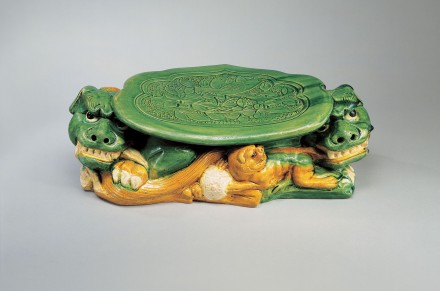J.J. Lally & Co., Oriental Art / New York City, New York
MenuPast Exhibition
Early Chinese Ceramics: An American Private Collection
March 28 - April 16, 2005

42.
A LARGE SANCAI-GLAZED POTTERY PILLOW SUPPORTED ON LIONS
Song Dynasty, A.D. 12th/13th Century
the headrest with wide concave top carved in low relief with a pair of songbirds perched on a leafy camellia spray reserved on a punched ground, all within a wide ruyi-shaped border and covered with a leaf-green glaze, the base sculpted in the form of two Buddhist lions shown reclining with their heads emerging at either end to face the observer with bold menacing expressions, their jaws clenched on trailing ribbons, the female with slightly smaller head identified by the small cub shown in front playing with a brocade ball, the lions covered with a green glaze and their backs conjoined to form the back of the pillow, their differently styled manes carved in relief on the back and glazed amber yellow, their eyes picked out in black and their teeth and claws glazed white, the cub splashed with amber and green and the brocade ball in white, the glazes all applied over a layer of white slip and unusually well controlled, the flat base left unglazed showing the smooth buff pottery body, the nostrils of the lions pierced through to serve as firing holes.
Length 15 1⁄4 inches (38.7cm)
The sancai-glazed pottery pillow on lion support is a well known type of Song dynasty pillow, but the sculptural quality, unusually large size and well controlled glazing of this example are rarely seen, and this is one of the finest examples of the type yet published.
Compare the smaller sancai-glazed pottery pillow of related design illustrated in color in the catalogue of the 1984 Osaka exhibition, Chinese Ceramic Pillows from Yeung Wing Tak Collection, Osaka, 1984, p. 56, no. 107, described on p. 211. Another example, also of smaller size, in the Ashmolean Museum, Oxford, is illustrated in color by Tregear in Song Ceramics, London, 1982, p. 85, no. 82.
宋 三彩獅形陶枕 長 38.7 厘米
42.
A LARGE SANCAI-GLAZED POTTERY PILLOW SUPPORTED ON LIONS
Song Dynasty, A.D. 12th/13th Century
Length 15 1⁄4 inches (38.7cm)